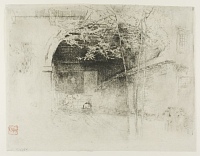Etchings Institutions search term: grolier club
Traghetto | ||
| Number: | 231 | |
| Date: | 1879/1880 | |
| Medium: | etching and drypoint | |
| Size: | 240 x 311 mm | |
| Signed: | butterfly at lower left (1-2); replaced with new butterfly (3-final) | |
| Inscribed: | no | |
| Set/Publication: | no | |
| No. of States: | 4 | |
| Known impressions: | 7 | |
| Catalogues: | K.190; M.187 | |
| Impressions taken from this plate (7) | ||
PUBLICATION
EXHIBITIONS
 ). 12 An impression was lent by James Cox-Cox (ca 1849- d.1901) to an International exhibition in Glasgow in 1901. In New York, one was for sale and on show by the New York print dealer, H. Wunderlich & Co. in 1903 and, after Whistler's death, one hung in the comprehensive show at the Grolier Club in 1904. 13
). 12 An impression was lent by James Cox-Cox (ca 1849- d.1901) to an International exhibition in Glasgow in 1901. In New York, one was for sale and on show by the New York print dealer, H. Wunderlich & Co. in 1903 and, after Whistler's death, one hung in the comprehensive show at the Grolier Club in 1904. 13
12: Chicago 1900 (cat. no. 137).
13: Glasgow 1901 (cat. no. 242); New York 1903 (cat. no. 71); New York 1904a (cat. no. 157).
SALES & COLLECTORS
 ), and another that Bacher sold to Charles Lang Freer (1856-1919) in 1904 (
), and another that Bacher sold to Charles Lang Freer (1856-1919) in 1904 ( ). Finally E. Gottschalk (dates unknown) owned another third state, which he sold to Freer in 1907 (
). Finally E. Gottschalk (dates unknown) owned another third state, which he sold to Freer in 1907 ( ). Thus Freer had three of the six known impressions of this rare etching.
). Thus Freer had three of the six known impressions of this rare etching. ). 15
). 15
Whistler had also written directly to Edward Guthrie Kennedy (1849-1932) on 4 July 1892, selling another impression that he claimed to be the 'first proof': 'I have found ... the first proof of the Traghetto - pulled on old wooden Press in Venice, as you will see marked on back - consequently a tit bit for one of your collectors - ' 16 For this he received £12.12.0. 17 This was probably the impression bought by Howard Mansfield (1849-1938), on which Mansfield wrote: 'Perhaps only impression of first state. The plate was destroyed and a new etching made of the subject. H.M.' (
 ).
).  ).
).  ).
). ).
).
